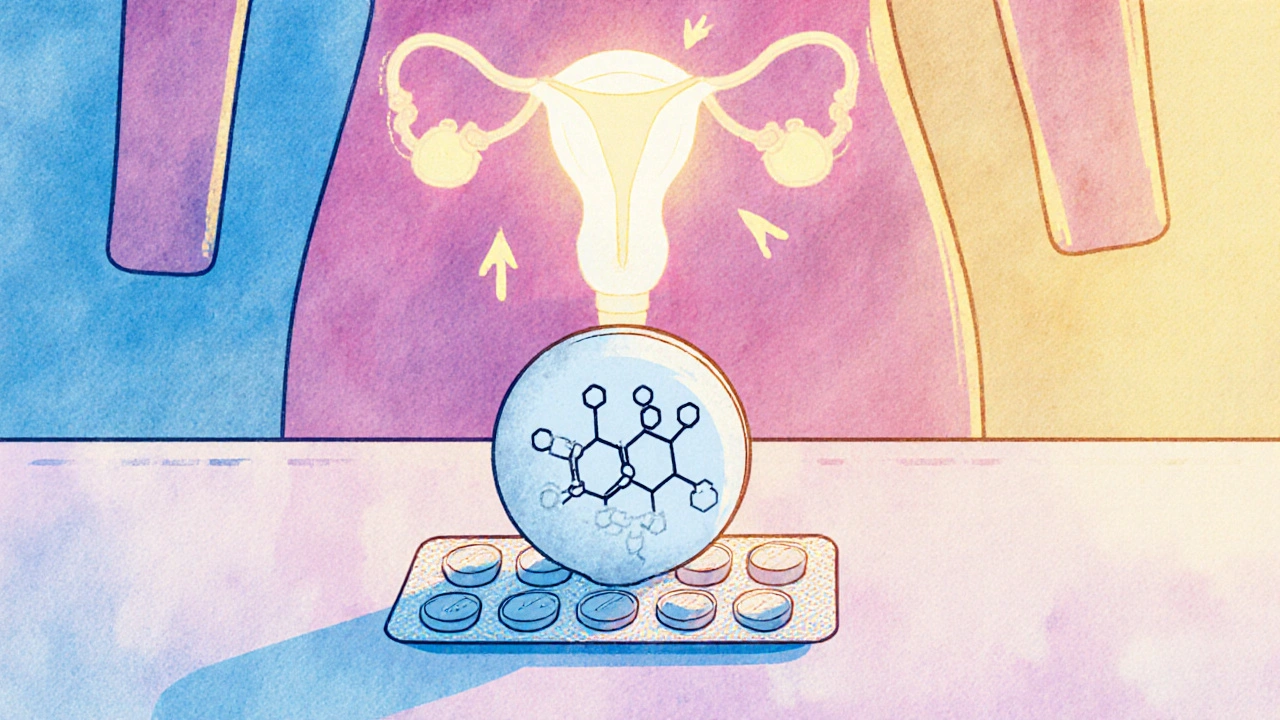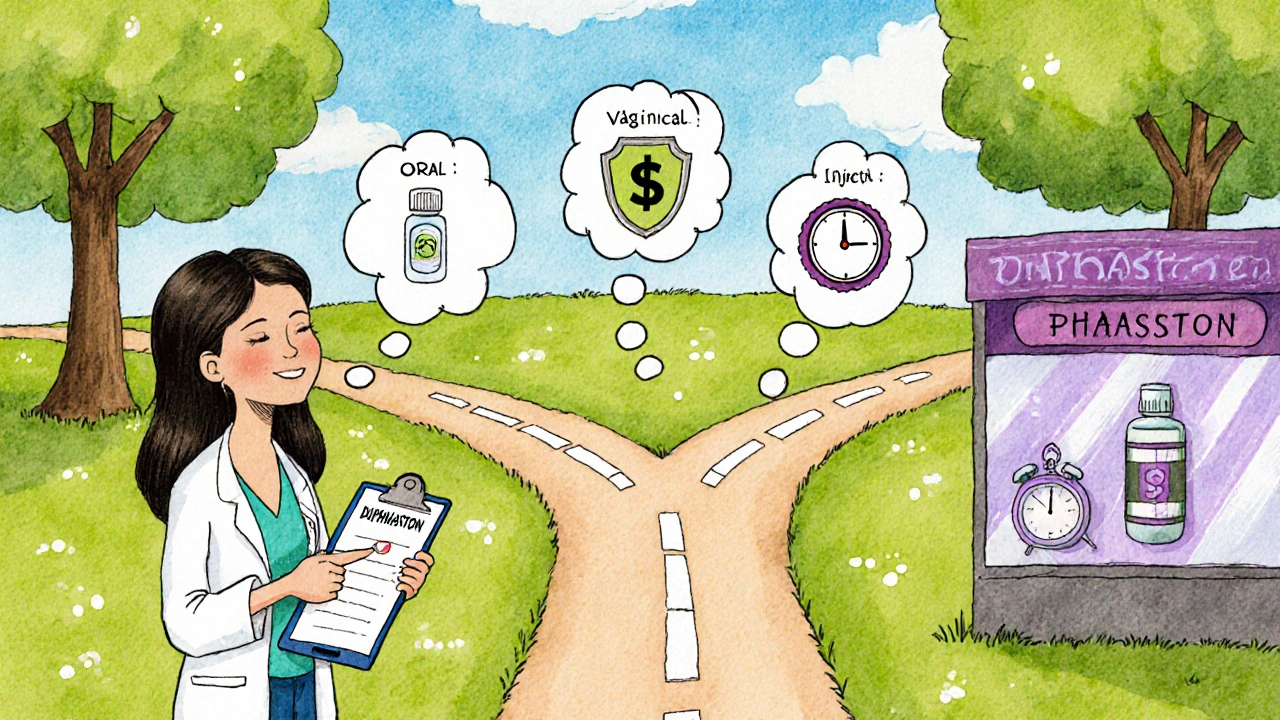Duphaston (Dydrogesterone) vs. Common Progesterone Alternatives - Detailed Comparison

Progesterone Medication Comparison Tool
Find Your Best Option
Select your priorities to see which progesterone medication best fits your needs.
If you’re hunting for a progesterone‑like pill, the brand Duphaston often shows up first in the search results. However, it’s not the only option, and understanding how it stacks up against other hormones can save you time, money, and unwanted side effects.
What Is Duphaston?
Duphaston is a synthetic progestogen marketed by Abbott. Its active ingredient is dydrogesterone, a molecule that mimics natural progesterone but with a slightly different shape, which gives it a more selective receptor profile.
Because of this selectivity, dydrogesterone tends to cause fewer androgenic side effects (like acne or oily skin) compared with some older progestins. It is commonly prescribed for luteal‑phase support in IVF, treatment of menstrual disorders, and management of threatened miscarriage.
How Duphaston Works
Dydrogesterone binds to progesterone receptors in the endometrium, stabilizing the uterine lining and reducing uterine contractility. This environment supports embryo implantation and helps regulate the menstrual cycle. Its oral bioavailability is about 70%, meaning most of the pill reaches systemic circulation.
Typical Indications for Duphaston
- Secondary amenorrhea or irregular periods
- Luteal‑phase support after assisted reproductive techniques
- Threatened or recurrent miscarriage
- Endometriosis‑related pain (as part of hormonal therapy)
- Premenstrual syndrome (PMS) with predominant irritability
Benefits and Risks of Duphaston
**Benefits** - High receptor selectivity, lower incidence of androgenic side effects, good oral absorption, and a short half‑life (≈14hours) that allows flexible dosing.
**Common Risks** - Nausea, breast tenderness, headache, and rare cases of thrombosis. Because it is a progestogen, long‑term high‑dose use should be monitored for lipid changes.
Key Progesterone Alternatives
Below are the most frequently prescribed alternatives, each with its own pros and cons.
- Progesterone - Natural micronized hormone, usually taken orally or vaginally.
- Medroxyprogesterone acetate (MPA) - A synthetic progestin found in Depo‑Provera injections and oral tablets.
- Norethisterone - An oral progestin often combined with estrogen in contraceptive pills.
- Micronized progesterone - Identical to endogenous progesterone, delivered in capsules or vaginal gel.
- Estradiol - An estrogen often paired with progesterone for hormone replacement therapy (HRT).
- Mifepristone - A progesterone receptor antagonist used for medical abortion and, off‑label, for certain uterine fibroids.
Side‑by‑Side Comparison
| Brand / Compound | Active Ingredient | Dosage Form | Typical Cost (USD per month) | FDA Status | Key Uses | Half‑Life | Side‑Effect Profile |
|---|---|---|---|---|---|---|---|
| Duphaston | Dydrogesterone | Oral tablet 10mg | $30‑$45 | Approved (EU); not FDA‑approved | Luteal support, menstrual disorders | ≈14h | Low androgenic effects; occasional nausea |
| Progesterone (Prometrium) | Micronized progesterone | Oral capsule 200mg | $25‑$35 | FDA‑approved | HRT, infertility, amenorrhea | ≈5h | Sedation, breast tenderness, dizziness |
| Depo‑Provera | Medroxyprogesterone acetate (MPA) | IM injection 150mg/3mo or oral 10mg | $20‑$30 (injection) | FDA‑approved | Contraception, endometrial hyperplasia | ≈30h (oral), longer depot effect (injectable) | Weight gain, mood swings, bone loss with long use |
| Microgynon (combo) | Norethisterone + Ethinyl estradiol | Oral tablet | $15‑$25 | FDA‑approved | Combined oral contraceptive | ≈7h | Increased clot risk, acne, nausea |
| Vaginal Progesterone Gel | Micronized progesterone | Vaginal gel 90mg daily | $40‑$60 | FDA‑approved for luteal support | IVF luteal phase, recurrent miscarriage | ≈5h | Local irritation, mild bloating |
| Mifepristone (RU‑486) | Mifepristone | Oral tablet 200mg | $100‑$150 (off‑label) | FDA‑approved for medical abortion | Pregnancy termination, uterine fibroids (off‑label) | ≈20h | Heavy bleeding, cramping, rare liver toxicity |

How to Choose the Right Option
Picking a progesterone‑type medication isn’t a one‑size‑fits‑all decision. Below are the main criteria to weigh:
- Therapeutic Goal: Want luteal support for IVF? Vaginal micronized progesterone or Duphaston are strong contenders. Managing heavy menstrual bleeding may lean toward MPA.
- Route of Administration: Oral tablets are convenient but may cause gastrointestinal upset. Vaginal gels deliver higher uterine concentrations with fewer systemic effects.
- Side‑Effect Tolerance: If you’re sensitive to androgenic side effects, avoid norethisterone‑based combos. Dydrogesterone’s selectivity often feels gentler.
- Regulatory Status: In the U.S., Duphaston isn’t FDA‑approved, which can affect insurance coverage. Choose an FDA‑approved alternative if reimbursement matters.
- Cost Considerations: Monthly cost varies widely. Generic micronized progesterone and MPA are usually the cheapest, while branded Duphaston and vaginal gels sit higher.
- Duration of Therapy: Long‑term HRT may favor agents with a well‑established safety record, such as micronized progesterone.
Practical Tips for Using Progesterone‑Type Medications
- Take oral tablets with food to reduce nausea.
- If you experience breast tenderness, try splitting the dose (e.g., 5mg twice daily instead of 10mg once).
- For vaginal gels, insert at bedtime; the pH of the vagina supports better absorption.
- Monitor blood pressure and lipid profile every 3‑6months if you’re on high‑dose progestins for more than six months.
- Always discuss any history of clotting disorders with your prescriber before starting combined estrogen‑progestin products.
Frequently Asked Questions
Is Duphaston the same as natural progesterone?
No. Duphaston contains dydrogesterone, a synthetic analogue that mimics many actions of natural progesterone but has a different chemical structure, giving it a more selective receptor binding profile.
Can I switch from Duphaston to micronized progesterone?
Switching is possible, but you should do it under medical supervision because dosage equivalence isn’t 1‑to‑1. Typically, 10mg of dydrogesterone equates to about 200mg of micronized progesterone for luteal support.
Why isn’t Duphaston FDA‑approved?
The manufacturer never filed a New Drug Application with the FDA, relying instead on European approvals where the drug has been used for decades. This limits its availability in the United States without a prescription from a specialist.
What are the main side effects of medroxyprogesterone acetate?
Common side effects include weight gain, mood swings, and decreased bone mineral density with long‑term use. Injectable forms can cause injection‑site pain.
Is vaginal progesterone more effective than oral tablets for IVF?
Studies show comparable pregnancy rates, but many patients prefer vaginal gels because they achieve higher uterine tissue concentrations with fewer systemic side effects.
Ultimately, the “best” choice depends on your specific condition, how your body reacts, and practical factors like cost and insurance coverage. Talk with your healthcare provider, weigh the criteria above, and you’ll land on the progesterone therapy that fits your life.
Man, Duphaston sounds like the fancy way pharma uses to sell a progestin. I mean, why bother with the brand when a cheap generic does the same job? The whole thing feels like a marketing hype, especially when the side‑effects are basically the same. Still, if it works for you, go ahead.
Don't be fooled by the glossy ads, brother. They’re pumping Duphaston into the market while the shadowy elites keep the real breakthrough hidden. Only the deep‑state knows the true hormonal conspiracies they don’t want us to read about. Trust the people, not the pharma giants.
When evaluating the pharmacological profile of dydrogesterone, it is imperative to consider both its receptor affinity and its metabolic clearance. Dydrogesterone exhibits a high degree of selectivity for the progesterone receptor, thereby reducing off‑target androgenic activity. This selectivity translates clinically into a lower incidence of acne and sebaceous gland hyperactivity compared with older progestins. The oral bioavailability, reported at approximately 70%, ensures adequate systemic exposure following enteric administration. Its half‑life of roughly 14 hours permits flexible dosing schedules without substantial accumulation. Moreover, the synthetic arrangement of its molecular scaffold confers resistance to hepatic first‑pass metabolism, enhancing its pharmacokinetic stability. In contrast, micronized progesterone, while bioidentical, suffers from variable absorption due to its lipophilic nature. Clinical trials have demonstrated comparable efficacy of dydrogesterone in luteal‑phase support for assisted reproductive technologies. Adverse event profiles remain favorable, with nausea and mild headache constituting the most common complaints. Nonetheless, vigilance for rare thrombotic complications remains warranted, particularly in patients with pre‑existing coagulopathies. Long‑term use necessitates periodic monitoring of lipid panels, given the progestogenic influence on hepatic lipid synthesis. The cost differential, albeit modest, may influence patient adherence in certain healthcare systems. Regulatory status in the United States remains restricted, as the compound enjoys approval predominantly within the European Union. Consequently, insurance coverage may be limited, prompting clinicians to consider alternative agents. The decision matrix for selecting an appropriate progestogen should integrate therapeutic goals, patient tolerance, and socioeconomic factors. Ultimately, dydrogesterone represents a viable, well‑tolerated option within the progestin armamentarium, provided that prescribers remain cognizant of its pharmacodynamic nuances.
Sure, because adding another “selective” progestin fixes everything, right?
Listen, I get that the whole hormonal circus can feel like an endless drama, but let me tell you why the story doesn’t end with just a fancy name on a pill. When you’re juggling IVF protocols, recurrent miscarriages, and that never‑ending PMS rollercoaster, you need something that actually sticks the landing without turning you into a walking acne billboard. Duphaston’s selective binding means fewer androgenic fireworks, which, for many, is a lifesaver when you’ve already got enough drama in the bedroom. Plus, the oral route is a godsend compared to those messy gels that leave you feeling like you’ve applied a science experiment to a delicate area. I’ve seen patients switch from micronized progesterone to dydrogesterone and finally experience that elusive calm before their period, and that’s not just placebo hype. Still, if you’re on a shoestring budget, the cost may still be a pinch, but the trade‑off in tolerability can be worth it. And yes, the lack of FDA approval is a bureaucratic nightmare, but many specialists still prescribe it under compassionate use protocols. In short, it’s not a miracle cure, but it’s a solid contender in the hormonal lineup, especially when you’re dealing with the emotional whirlwind of reproductive challenges.
Honestly, the whole Duphaston hype feels overrated 😒. If you can grab a generic micronized progesterone for half the price, why waste cash? The side‑effects are practically identical, and you avoid the whole FDA‑approval drama. Still, if your doc swears by it, maybe give it a try-just don’t expect miracles.
Okay, I have to say the emotional roller‑coaster of choosing a progesterone is real. I’ve been through the whole Duphaston vs. micronized saga and felt drained every single time I read another article promising the “perfect” pill. It’s exhausting when the side‑effects feel like a personal attack and the cost keeps haunting you. Still, I found that splitting the dose of any progestin, whether Duphaston or natural progesterone, helped my body adjust without dramatic mood swings. Also, don’t underestimate the power of taking it with food; my nausea vanished after I started a simple breakfast routine. And yes, the insurance tug‑of‑war is a nightmare-I’ve filed appeals just to get a fraction of the coverage I need. All that aside, I’m grateful for the community’s shared experiences because they guide us through the fog of pharmaceutical jargon and marketing fluff. Keep sharing, it really helps us survive the hormonal labyrinth.
It's important to approach hormone therapy with a balanced perspective. Consider both efficacy and patient-specific tolerability when selecting a regimen. Open communication with your healthcare provider ensures optimal outcomes.
Yo, Duphaston is ok but not a game changer. If it works for u, good luck.
That's a fair take-sometimes the simplest solution is the best. Keep an eye on how your body reacts and adjust as needed.
Imagine navigating the labyrinth of hormonal choices with confidence! Each drug is a stepping stone toward the sunrise of health and harmony. Embrace the journey, trust the science, and let optimism be your guide. You’ve got this.
so yeah Duphaston works but also costs more
Let me be crystal clear 🤓: the pharmacodynamics of dydrogesterone are far superior when you appreciate the nuanced interplay of receptor selectivity and metabolic pathways. If you ignore this, you’re essentially denying yourself the pinnacle of endocrine optimization. 🚀